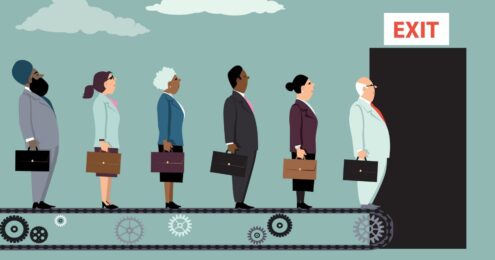I am asked with some regularity to coach Chief Diversity Officers. I am tempted because helping an organization to become more culturally competent, where everyone has a true sense of belonging, is important to me.
But I always say no. I can’t coach them to success. They are not set up for it.
Now, I run a small and thriving business that serves nonprofit leaders. Even if we grew 10x I wouldn’t hire a Chief Diversity Officer.
ATTRITION IS SKYROCKETING
In the wake of the murder of George Floyd by police in 2020, organizations everywhere, for-profits and nonprofits of all sizes embraced the call to address systemic racism in nearly every sector of our country. Issues of diversity, equity, and inclusion were elevated within their own company cultures and values.
Senior positions charged with leading diversity initiatives increased by 55%. But today, attrition in these roles is skyrocketing, with one report finding that attrition among “Chief Diversity Officer” positions is at an astounding 33% – and most of those leaving are diverse leaders themselves.
Organizations and companies are blaming the economy. I blame their model.
While the intent behind creating these senior leadership positions to address inequity was well intended, they were never really set up to succeed in the first place. Here’s why.
These positions were expected to do “all the things” for “all the people” with little to no resources. They had a trendy title, access to power …. and little authority to make the changes necessary to make a difference.
A SMALL BUSINESS’ APPROACH TO DIVERSITY, EQUITY, AND INCLUSION
The Nonprofit Leadership Lab, founded by myself and my business partner Scott Paley, is a mission-driven online hub dedicated to amplifying the impact of nonprofit leaders in North America and throughout the world. Through expert training, crucial support, and a robust community, we’ve supported nearly 20,000 small to medium-sized nonprofits in their journey towards sustainability and growth, all while promoting a healthy work-life balance for leaders.
Once our startup became profitable, we discussed how best to resource a diversity, equity, and inclusion (DEI) journey for our small team and the thousand of leaders we call members.
We knew we couldn’t afford a full-time senior diversity staff member on a team of 15, an obstacle many small and medium-sized businesses also face. Yet, as I look at our journey these last two years, I find myself not just proud of the model we adopted to realize our aspirations, but also relieved that we couldn’t follow the trend that bigger companies were getting behind.
Our approach offers an alternative for companies large and small and reminds me daily that the work of becoming an organization where everyone feels a true sense of belonging is not about a job, or a role, but is, instead, the responsibility of every person who joins a team and lives in every nook and cranny of your business.
So what did we do to facilitate this deep culture change that so many other businesses have failed to realize?
6 STEPS IN OUR JOURNEY (SO FAR…)
First, we invested in resources and expertise – but not in a single person. Not a Chief Diversity Officer. Our first big move was to partner with a group that was focusing intensely on solutions to these systemic problems. We chose The Raben Group, a widely respected firm that helps companies and organizations address big, complex issues. The project lead, Dr. Pablo Otaola, is an expert in organizational change as well as in bringing diversity visions to life.
DEI work is a profound effort to change the culture of a company, and expecting one single staff member to affect that change is, quite simply, setting them up for failure.
Second, we committed as a company to doing the work together. We fielded an internal working group of five, each team member bringing their lived experience and commitment to the table. We intentionally engaged millennial and GenZ team members so that others on our staff could understand and benefit from their sense of urgency for change.
What we learned was eye-opening: Our organization was, at best, reactive to DEI. We weren’t being proactive in making ourselves, or our company, better.
Then third – working together – we did the work that, too often, big companies were relying on a single person to do for them alone. Chief Diversity Officers.
Fourth, we built foundational documents that forced us to build a solid moral and business case for our ‘why.’
Fifth, we transformed our performance review process, embedding values and goals to ensure that each team member is accountable for bringing our DEI vision to life.
And sixth, we instituted a hiring process I am proud to say is best in class: We scrub resumes to eliminate biases, create rubrics of skills, experience, and attributes and our job postings are welcoming. As a result of this process, we have made four new hires in the last 12 months and each of the four adds a level of diversity to our team.
That’s a track record any company of any size could be proud of. And it’s a model more of us need to embrace if we are going to truly tackle bias and inequity at the corporate or nonprofit level in a real, meaningful way that doesn’t put the (impossible) burden of doing so on a single, senior-level hire or edicts from above.
OUR NEXT STEPS
As we continue this journey, Scott and I are happily taking a backseat. As we move forward we are offering leadership opportunities to members of our team to lead our working group with coaching from Dr. Otaola, now with his own firm, Thriving Culture. The Nonprofit Leadership Lab is on an intentional journey, poised to fuel and inspire leaders of small to mid-sized nonprofits with greater capacity to lead, manage and change the world.
Make no mistake. This model is not a light lift, especially for a small organization. We have invested significant time and financial resources and will continue to do so as we continue to learn and develop into a team and a business where you can find our DEI vision everywhere you look.
It is yet another example of the small, creative, and nimble leading the way with innovative ideas that are succeeding where big corporate policies and trends have come up short.
And it underscores that when tackling even our biggest problems – as a company, society, or country – we should never underestimate the small nonprofit or small business. They can offer some mighty lessons and create big change along the way.



